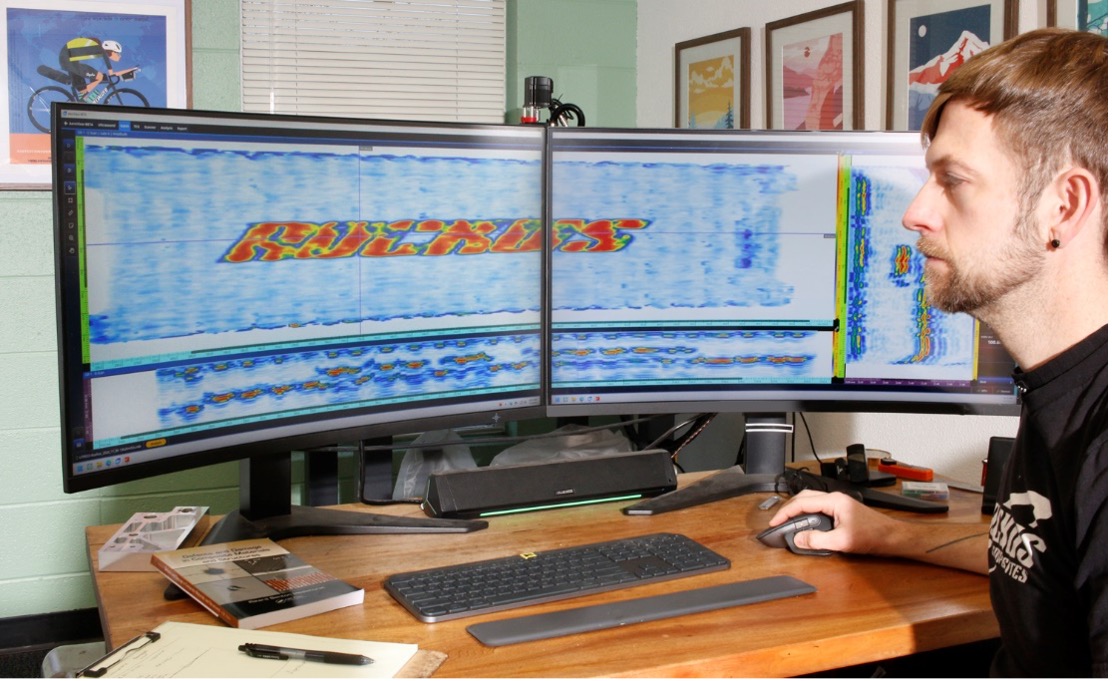Shawn Small founded Ruckus Composites in 2008 as a way to combine his love of bicycle technology, his degree in mechanical engineering, and his desire to make a positive impact on our world.

Inspecting a diverse range of carbon fiber parts demands custom phased array probes.
Since that time, Ruckus has inspected more than 8000 carbon fiber bicycle frames using ultrasound inspection technology from Evident. Through their experience and composite research, Shawn and the Ruckus team have become internationally recognized as leaders in ultrasonic inspection, the repair and creation of carbon fiber components, and impactful environmentalism.
By 2019, Shawn had expanded Ruckus’ carbon fiber capabilities beyond bike frames to the point where he decided to create a secondary company—Ruckus Space—to serve industrial, automotive, and aerospace clients with a need for innovative inspection, repair, and design services.

Shawn adapts the software’s flexible layout to optimize the views for his inspection needs.
Following this expansion, Ruckus began using our AeroView™ Analysis software, which we designed specifically for aviation-based phased array ultrasonic data analysis. I spoke with Shawn recently to get his feedback.
How Fit for Purpose Is AeroView™ Software?
Q: Hi Shawn. First, can you tell us about Ruckus Space and how it came to be?
A: About five years ago, as the composite inspection side of Ruckus Composites got more and more busy, I spun off a secondary company to house all our composite inspections, and to get more specialized in terms of the types of customers we can serve. To do this, we began accumulating more equipment, assets, intellectual property, and patent filings, which became geared toward three primary audiences—industrial, automotive, and aerospace. This became Ruckus Space.
Q: How has Evident’s AeroView Analysis software, which you use with yourOmniScan™ X3 flaw detector, been helpful for Ruckus Space?
A: On the aerospace side of things, AeroView has really accelerated our ability to analyze carbon fiber tubing. For example, I will be spending the rest of this week on aircraft inspection—I believe I will be inspecting 60 on-craft carbon fiber tubes in that time frame. We do a lot of on-craft inspection, and we analyze that data using AeroView.

Loading a carbon fiber tube into a tube immersion tank.
With AeroView, we are also now able to do a lot of automated immersion scanning—we’ve built four of our own immersion scanner tanks. Two are tube-related, and we can scan up to a three-meter tube—this is where AeroView is critical. With these scanner tanks, we’ll do a lot of preinstallation, especially on tubing. We’ll basically go through a company’s entire inventory of carbon fiber tubes—I think I have thousands of tubes to go through at the moment. Using automated immersion scanning and an OmniScan X3, we can scan a tube in around three minutes, and then use AeroView to analyze our scanning data.

A custom driver assembly for a tube immersion tank.
Q: What do you see as the main benefits of using AeroView software as part of your carbon fiber inspection process?
A: What really pushed me specifically toward AeroView was our immersion scanning needs and the limitations we had at that point in time, specifically in the ways we had to scan—our machine could only record information in one direction. So basically, one of the main benefits I see from AeroView is the ability to rotate data 90° and manipulate the gates and gate alignment for C-scan image generation.
And as simple as that sounds, the software we had used previously did not allow us to do that. And since I scan really, really long tubes that are very small in diameter, the way our data files would be built was very cumbersome. With AeroView, the ability to rotate data and better lay it out and organize the data screens has been a huge advantage for us.
Another main benefit of AeroView is that it is dramatically faster than other inspection software we have used. The AeroView interface feels very modern, and it’s downright quick. I like that I can align and rebuild all my gates as well—I can kind of flatten everything to the echo and do all of my gate-building off of that in AeroView, and do it very quickly.
That’s really, really nice, and it allows me to pretty much eliminate any immersion tank, machining, tolerance, or application issues. If there’s any sort of movement in the tube or runout on some of the bearings or something like that, AeroView allows us to really flatten and organize all of our data in a simpler way, which gives us a really good and really quick way to analyze for defects.

Custom flat plate specimens loaded into a three-axis gantry immersion tank.
Q: What kind of difference do you see in terms of analysis quality with AeroView vs. other software systems you have used in the past?
A: Before, I couldn’t even do some of the things we are doing now with AeroView. With other software, I couldn’t do immersion scans or automated scans, but now the quality of my data is so much better that I can do them, and in high resolution. This is huge for us. It has opened up a ton of opportunities for Ruckus Space, in terms of scanning carbon fiber tubes alone.
The sheer amount of ultrasound inspection data that we’re generating and analyzing right now is massive. Our analysis is faster, our data is much better, and our resolution is dramatically better. We also have a lot more flexibility in how we analyze our data. AeroView has created a lot of new opportunity for us.
Q: Thank you, Shawn, we always appreciate hearing more about how our products are helping our customers make new strides forward.
A: Always happy to share. Evident has always been super helpful with me, and I appreciate the back and forth as well. At Ruckus Space, we are attracting a lot of hard-to-inspect parts, and we will continue to need the right tools to meet the needs of composite fiber clients from all over the world.
Learn More about AeroView Analysis Software
Compatible with the .nde data format, AeroView Analysis software can be used to analyze PAUT data acquired at 0° (with overlap) using the following instruments:
- OmniScan X3 flaw detectors (all models)
- OmniScan X4 flaw detectors (all models)
- QuickScan iX™ PA+ data acquisition units
AeroView Analysis is also compatible with AeroView Inspection software when used in conjunction with an OmniScan X4 or QuickScan iX™ PA+ unit for data acquisition. Learn about more about the analysis tools offered by AeroView software here.
Streamline Your Workflow with AeroView Inspection Software
With AeroView Inspection software, operators can acquire PAUT data directly on a PC or laptop via an OmniScan X4 unit running the OmniScan Black Box app or a QuickScan iX PA+ data acquisition unit. Using this configuration eliminates the need to transfer data prior to analysis. To further increase productivity, AeroView Inspection also provides the flexibility to analyze an inspected part while scanning a new one, as two instances can be open on one computer. AeroView Inspection is compatible with all 128-receiver-channel OmniScan X4 models (those ending in :128) and all QuickScan iX PA+ units.
If you would like more information, a demo, or a quote, reach out to your local Evident representative or contact us here.
Related Content
From Basic UT to Advanced AI-Based Customization: Ruckus Composites’ Extreme NDE 4.0 Transformation
Ruckus Composites Inspects Thousands of Bikes with One Ultrasonic Thickness Gauge

